| Silvery-throated jay | |
|---|---|

| |
| Near Savegre, Costa Rica | |
| Conservation status | |
 Least Concern (IUCN 3.1) | |
| Scientific classification | |
| Domain: | Eukaryota |
| Kingdom: | Animalia |
| Phylum: | Chordata |
| Class: | Aves |
| Order: | Passeriformes |
| Family: | Corvidae |
| Genus: | Cyanolyca |
| Species: | C. argentigula |
| Binomial name | |
| Cyanolyca argentigula (Lawrence, 1875) | |

| |
The silvery-throated jay (Cyanolyca argentigula) is a species of bird in the family Corvidae. It is found in the Talamancan montane forests of Costa Rica and western Panama. The IUCN has rated its conservation status as being of "least concern".
Description
The silvery-throated jay is a distinctive small jay, unlikely to be confused with any other bird found within its range. The sexes are similar, with the adult being about 26 cm (10 in) in length including the long tail. The head is black with a narrow but obvious white supercilium, and it bears an inconspicuous crest of short stiff feathers on the forehead. The throat and breast are silvery-white, sometimes with a violet sheen. The mantle, neck and sides of breast are black which gradually blends into the dark purplish-blue of the rest of the plumage. The upper surfaces of the wings and tail are a brighter, paler shade of blue and the undersides are blackish. The irises are deep red and the bill and legs are black. The plumage of the juvenile is duller and lacks the white on the head.
Ecology
A sociable bird, it moves through the upper parts of the forest canopy in groups of four to ten. Outside the breeding season, larger groups of up to thirty may form, and they tend to roost communally, settling down for the night with much chatter. When foraging, they move methodically through the crowns of trees, searching in crevices and probing into mosses, lichens and other epiphytes. They feed on insects and other invertebrates, amphibians, lizards, fruit and berries. The breeding season is in the period March to June, but little is known about the nest and eggs of this bird.
Status
Cyanocorax argentigula is native to Costa Rica and Panama where it lives in moist cloud forest at altitudes between 2,000 and 3,200 m (6,600 and 10,500 ft). It is a relatively uncommon species, and at around 3,900 square kilometres (1,500 sq mi) its total area of occupancy is small, but the population seems stable and the International Union for Conservation of Nature has rated its conservation status as being of "least concern".
References
- ^ BirdLife International (2020). "Cyanolyca argentigula". IUCN Red List of Threatened Species. 2020: e.T22705678A137756354. doi:10.2305/IUCN.UK.2020-3.RLTS.T22705678A137756354.en. Retrieved 12 November 2021.
- ^ Madge, Steve (2010). Crows and Jays. Bloomsbury Publishing. pp. 78–79. ISBN 978-1-4081-3169-5.
External links
 Media related to Cyanolyca argentigula at Wikimedia Commons
Media related to Cyanolyca argentigula at Wikimedia Commons Data related to Cyanolyca argentigula at Wikispecies
Data related to Cyanolyca argentigula at Wikispecies
| Taxon identifiers | |
|---|---|
| Cyanolyca argentigula |
|